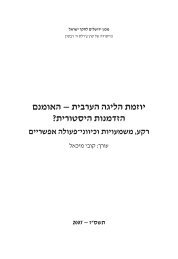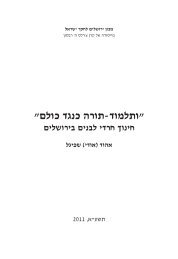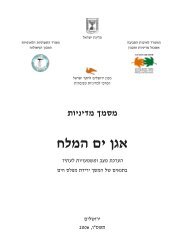כל הזכויות שמורות למכון ירושלים לחקר ישראלof similar population into the surrounding metropolitan area; and to create inthe city about 60,000-70,000 high level 'creative' new jobs in the private andthe public sectors. The additional strong population will come from the outside,through the upgrading of the level of non-Haredi families in the city and by theincrease in the number of Haredim who seek professional and high education andhigh level positions.While the focus of the program is on raising the proportion of the strongsegment of the population in Jerusalem, the 'vision' guarantee the preservation ofthe rights and way of life of all parts of the population and takes advantage of thepluralistic composition of the city.The project devote attention, and chapters, to improvements in all aspects oflife in the city — education, culture, urban infrastructure, especially in its center,and services, housing, new high level industries, including in IT and tourism, allnecessary for achieving the goals. 4However, the project specifically concentrateson three elements that serve as the main drivers of the renewal process.The first push will be provided by doubling the capacity of the highereducation and research sectors, based on the strong foundation of the HebrewUniversity campuses and the major medical centers. This will directly createhigh level jobs, will give new momentum to the development of new high-endindustries, and will bring to Jerusalem additional thousands of students who willenliven its urban and cultural life and become ,potential candidates for taking uppermanent residence in the city.The second key element of the project is the development of inter-sectoralnetworks of mutual support: high education and research to industry, to thepublic sector, to the lifting of the education level in the city, to its culture; studentOinvolvement in education, in cultural life, as interns in the new industries etc. Inthis way the whole will far exceed the sum of the sectoral efforts.Finally, the third key element is the assignment of the implementation of theproject to a high level task-force composed of representatives of the government,the municipality, Jewish organizations worldwide, philanthropic institutions andfoundations, and the business community. The task force will be in charge ofdesigning the project, providing its budget and overseeing its implementation.4See the attached Table of Contenets.viii
כל הזכויות שמורות למכון ירושלים לחקר ישראלIn light of the aforementioned, immediate and intensive effort is requiredto halt and reverse the declining trends; otherwise Jerusalem will continueto sink into poverty and its status as the capital of Israel and of the Jewishpeople will be threatened."A Vision for Jerusalem" is the name of a plan for the revitalizing and rejuvenationof Jerusalem. The initiative for the plan came from a group of funds active inJerusalem, and the work was undertaken by an independent group of researchersrelying on the ideas and extensive efforts invested in the plans for renewal in thecity, such as the new master plans prepared for the city and the region, the workof the coalition for a Sustainable Jerusalem, and more. 2The project, "A Visionfor Jerusalem" implements models developed in recent decades for the renewaland re-building of decaying cities around the world, of "Creative City", "City ofWisdom", and "Consumer City" 3 , while preserving and taking advantage of thecultural traditions, historical assets, and modern human infrastructure of humancapital existing in Jerusalem. These assets are particularly appropriate for theimplementation of these renewal models.The "Vision for Jerusalem" concentrates mostly on the development ofIsraeli Jerusalem. It assumes, realistically or not, that the development of mostof the parts of the cijy inhabited by Palestinians will eventually be governedby a Palestinian entity, and the work devotes a chapter to such an eventuality.This approach allows the group involved to concentrate on what is realisticallydoable in the Jewish parts of the city, and is also based on the assumption thatonly a significant improvement in the security and political situation surroundingJerusalem can make the project feasible and realistic.The target of the project is, by 2020, to increase the non-Haredi population ofJerusalem by about 100,000 people, consisting mostly of 'strong' and 'creative'families of high socioeconomic status and human capital; to draw another 100,000Cohen, M. (with the team he directed), Local Master Plan for Jerusalem 2000, Reports 1-4. The2Jerusalem Municipality 2001-2004; Regional Master Plan; Choshen, M., Hasson, I., and Kimhi, I.,(eds.), Sustainable Jerusalem, The Jerusalem Institute for Israel Studies, 2004 [in Hebrew].See for example: Clark, Terry N. (ed.). The City as an Entertainment Machine. Research in Urban3Policy, Vol 9. Amsterdam: Elsevier-JAI Press, 2004. Florida, R. The Rise of the Creative Class. NewYork: Basic Books, 2004. Glaeser, E. L. et al. "Consumer City", Journal of Economic Geography,Vol. 1 2001, pp. 27-50. Glaeser, E. and A. Saiz, "The Rise of the Skilled City." Brookings-WhartonPapers on Urban Affairs, 2004. [Hamutal, please add here Porter, 2000]vii
- Page 1:
כל הזכויות שמורות ל
- Page 5 and 6:
כל הזכויות שמורות ל
- Page 7 and 8:
כל הזכויות שמורות ל
- Page 9 and 10:
כל הזכויות שמורות ל
- Page 11 and 12:
כל הזכויות שמורות ל
- Page 13 and 14:
כל הזכויות שמורות ל
- Page 15 and 16:
כל הזכויות שמורות ל
- Page 17 and 18:
כל הזכויות שמורות ל
- Page 19 and 20:
כל הזכויות שמורות ל
- Page 21 and 22:
כל הזכויות שמורות ל
- Page 23 and 24:
כל הזכויות שמורות ל
- Page 25 and 26:
כל הזכויות שמורות ל
- Page 27 and 28:
כל הזכויות שמורות ל
- Page 29 and 30:
כל הזכויות שמורות ל
- Page 31 and 32:
כל הזכויות שמורות ל
- Page 33 and 34:
כל הזכויות שמורות ל
- Page 35 and 36:
כל הזכויות שמורות ל
- Page 37 and 38:
כל הזכויות שמורות ל
- Page 39 and 40:
כל הזכויות שמורות ל
- Page 41 and 42:
כל הזכויות שמורות ל
- Page 43 and 44:
כל הזכויות שמורות ל
- Page 45 and 46:
כל הזכויות שמורות ל
- Page 47 and 48:
כל הזכויות שמורות ל
- Page 49 and 50:
כל הזכויות שמורות ל
- Page 51 and 52:
כל הזכויות שמורות ל
- Page 53 and 54:
כל הזכויות שמורות ל
- Page 55 and 56:
כל הזכויות שמורות ל
- Page 57 and 58:
כל הזכויות שמורות ל
- Page 59 and 60:
כל הזכויות שמורות ל
- Page 61 and 62:
כל הזכויות שמורות ל
- Page 63 and 64:
כל הזכויות שמורות ל
- Page 65 and 66:
כל הזכויות שמורות ל
- Page 67 and 68:
כל הזכויות שמורות ל
- Page 69 and 70:
כל הזכויות שמורות ל
- Page 71 and 72:
כל הזכויות שמורות ל
- Page 73 and 74:
כל הזכויות שמורות ל
- Page 75 and 76:
כל הזכויות שמורות ל
- Page 77 and 78:
כל הזכויות שמורות ל
- Page 79 and 80:
כל הזכויות שמורות ל
- Page 81 and 82:
כל הזכויות שמורות ל
- Page 83 and 84:
כל הזכויות שמורות ל
- Page 85 and 86:
כל הזכויות שמורות ל
- Page 87 and 88:
כל הזכויות שמורות ל
- Page 89 and 90:
כל הזכויות שמורות ל
- Page 91 and 92:
כל הזכויות שמורות ל
- Page 93 and 94:
כל הזכויות שמורות ל
- Page 95 and 96:
כל הזכויות שמורות ל
- Page 97 and 98:
כל הזכויות שמורות ל
- Page 99 and 100:
כל הזכויות שמורות ל
- Page 101 and 102:
כל הזכויות שמורות ל
- Page 103 and 104:
כל הזכויות שמורות ל
- Page 105 and 106:
כל הזכויות שמורות ל
- Page 107 and 108:
כל הזכויות שמורות ל
- Page 109 and 110:
כל הזכויות שמורות ל
- Page 111 and 112:
כל הזכויות שמורות ל
- Page 113 and 114:
כל הזכויות שמורות ל
- Page 115 and 116:
כל הזכויות שמורות ל
- Page 117 and 118:
כל הזכויות שמורות ל
- Page 119 and 120:
כל הזכויות שמורות ל
- Page 121 and 122:
כל הזכויות שמורות ל
- Page 123 and 124:
כל הזכויות שמורות ל
- Page 125 and 126:
כל הזכויות שמורות ל
- Page 127 and 128:
כל הזכויות שמורות ל
- Page 129 and 130:
כל הזכויות שמורות ל
- Page 131 and 132:
כל הזכויות שמורות ל
- Page 133 and 134:
כל הזכויות שמורות ל
- Page 135 and 136:
כל הזכויות שמורות ל
- Page 137 and 138:
כל הזכויות שמורות ל
- Page 139 and 140:
כל הזכויות שמורות ל
- Page 141 and 142:
כל הזכויות שמורות ל
- Page 143 and 144:
כל הזכויות שמורות ל
- Page 145 and 146:
כל הזכויות שמורות ל
- Page 147 and 148:
כל הזכויות שמורות ל
- Page 149 and 150:
כל הזכויות שמורות ל
- Page 151 and 152:
כל הזכויות שמורות ל
- Page 153 and 154:
כל הזכויות שמורות ל
- Page 155 and 156:
כל הזכויות שמורות ל
- Page 157 and 158:
כל הזכויות שמורות ל
- Page 159 and 160:
כל הזכויות שמורות ל
- Page 161 and 162:
כל הזכויות שמורות ל
- Page 163 and 164:
כל הזכויות שמורות ל
- Page 165 and 166:
כל הזכויות שמורות ל
- Page 167 and 168:
כל הזכויות שמורות ל
- Page 169 and 170:
כל הזכויות שמורות ל
- Page 171 and 172:
כל הזכויות שמורות ל
- Page 173 and 174:
כל הזכויות שמורות ל
- Page 175 and 176:
כל הזכויות שמורות ל
- Page 177 and 178:
כל הזכויות שמורות ל
- Page 179 and 180:
כל הזכויות שמורות ל
- Page 181 and 182:
כל הזכויות שמורות ל
- Page 183 and 184:
כל הזכויות שמורות ל
- Page 185 and 186:
כל הזכויות שמורות ל
- Page 187 and 188:
כל הזכויות שמורות ל
- Page 189 and 190:
כל הזכויות שמורות ל
- Page 191 and 192:
כל הזכויות שמורות ל
- Page 193 and 194:
כל הזכויות שמורות ל
- Page 195 and 196:
כל הזכויות שמורות ל
- Page 197 and 198:
כל הזכויות שמורות ל
- Page 199 and 200:
כל הזכויות שמורות ל
- Page 201 and 202:
כל הזכויות שמורות ל
- Page 203 and 204:
כל הזכויות שמורות ל
- Page 205 and 206:
כל הזכויות שמורות ל
- Page 207 and 208:
כל הזכויות שמורות ל
- Page 209 and 210:
כל הזכויות שמורות ל
- Page 211 and 212:
כל הזכויות שמורות ל
- Page 213 and 214:
כל הזכויות שמורות ל
- Page 215 and 216:
כל הזכויות שמורות ל
- Page 217 and 218:
כל הזכויות שמורות ל
- Page 219 and 220:
כל הזכויות שמורות ל
- Page 221 and 222:
כל הזכויות שמורות ל
- Page 223 and 224:
כל הזכויות שמורות ל
- Page 225 and 226:
כל הזכויות שמורות ל
- Page 227 and 228:
כל הזכויות שמורות ל
- Page 229 and 230:
כל הזכויות שמורות ל
- Page 231 and 232:
כל הזכויות שמורות ל
- Page 233 and 234:
כל הזכויות שמורות ל
- Page 235 and 236:
כל הזכויות שמורות ל
- Page 237 and 238:
כל הזכויות שמורות ל
- Page 239 and 240:
כל הזכויות שמורות ל
- Page 241 and 242:
כל הזכויות שמורות ל
- Page 243 and 244:
כל הזכויות שמורות ל
- Page 245 and 246:
כל הזכויות שמורות ל
- Page 247 and 248:
כל הזכויות שמורות ל
- Page 249 and 250:
כל הזכויות שמורות ל
- Page 251 and 252:
כל הזכויות שמורות ל
- Page 253 and 254:
כל הזכויות שמורות ל
- Page 255 and 256:
כל הזכויות שמורות ל
- Page 257 and 258:
כל הזכויות שמורות ל
- Page 259 and 260:
כל הזכויות שמורות ל
- Page 261 and 262:
כל הזכויות שמורות ל
- Page 263 and 264:
כל הזכויות שמורות ל
- Page 265 and 266:
כל הזכויות שמורות ל
- Page 267 and 268:
כל הזכויות שמורות ל
- Page 269 and 270:
כל הזכויות שמורות ל
- Page 271 and 272:
כל הזכויות שמורות ל
- Page 273 and 274:
כל הזכויות שמורות ל
- Page 275 and 276:
כל הזכויות שמורות ל
- Page 277 and 278:
כל הזכויות שמורות ל
- Page 279 and 280:
כל הזכויות שמורות ל
- Page 281 and 282:
כל הזכויות שמורות ל
- Page 283 and 284:
כל הזכויות שמורות ל
- Page 285 and 286:
כל הזכויות שמורות ל
- Page 287 and 288:
כל הזכויות שמורות ל
- Page 289 and 290:
כל הזכויות שמורות ל
- Page 291 and 292:
כל הזכויות שמורות ל
- Page 293 and 294:
כל הזכויות שמורות ל
- Page 295 and 296:
כל הזכויות שמורות ל
- Page 297 and 298:
כל הזכויות שמורות ל
- Page 299 and 300:
כל הזכויות שמורות ל
- Page 301 and 302:
כל הזכויות שמורות ל
- Page 303 and 304:
כל הזכויות שמורות ל
- Page 305 and 306:
כל הזכויות שמורות ל
- Page 307 and 308:
כל הזכויות שמורות ל
- Page 309 and 310:
כל הזכויות שמורות ל
- Page 311 and 312:
כל הזכויות שמורות ל
- Page 313 and 314:
כל הזכויות שמורות ל
- Page 315 and 316:
כל הזכויות שמורות ל
- Page 317 and 318:
כל הזכויות שמורות ל
- Page 319 and 320:
כל הזכויות שמורות ל
- Page 321 and 322:
כל הזכויות שמורות ל
- Page 323 and 324:
כל הזכויות שמורות ל
- Page 325 and 326:
כל הזכויות שמורות ל
- Page 327 and 328:
כל הזכויות שמורות ל
- Page 329 and 330:
כל הזכויות שמורות ל
- Page 331 and 332:
כל הזכויות שמורות ל
- Page 333 and 334:
כל הזכויות שמורות ל
- Page 335 and 336:
כל הזכויות שמורות ל
- Page 337 and 338:
כל הזכויות שמורות ל
- Page 339 and 340:
כל הזכויות שמורות ל
- Page 341 and 342:
כל הזכויות שמורות ל
- Page 343 and 344:
כל הזכויות שמורות ל
- Page 345 and 346:
כל הזכויות שמורות ל
- Page 347 and 348:
כל הזכויות שמורות ל
- Page 349 and 350:
כל הזכויות שמורות ל
- Page 351 and 352:
כל הזכויות שמורות ל
- Page 353 and 354:
כל הזכויות שמורות ל
- Page 355 and 356:
כל הזכויות שמורות ל
- Page 357 and 358:
כל הזכויות שמורות ל
- Page 359 and 360:
כל הזכויות שמורות ל
- Page 361 and 362:
כל הזכויות שמורות ל
- Page 363 and 364:
כל הזכויות שמורות ל
- Page 365 and 366:
כל הזכויות שמורות ל
- Page 367 and 368:
כל הזכויות שמורות ל
- Page 369 and 370:
כל הזכויות שמורות ל
- Page 371 and 372:
כל הזכויות שמורות ל
- Page 373 and 374:
כל הזכויות שמורות ל
- Page 375 and 376:
כל הזכויות שמורות ל
- Page 377 and 378:
כל הזכויות שמורות ל
- Page 379 and 380:
כל הזכויות שמורות ל
- Page 381 and 382:
כל הזכויות שמורות ל
- Page 383 and 384:
כל הזכויות שמורות ל
- Page 385 and 386:
כל הזכויות שמורות ל
- Page 387 and 388:
כל הזכויות שמורות ל
- Page 389 and 390:
כל הזכויות שמורות ל
- Page 391 and 392:
כל הזכויות שמורות ל
- Page 393 and 394:
כל הזכויות שמורות ל
- Page 395 and 396:
כל הזכויות שמורות ל
- Page 397 and 398:
כל הזכויות שמורות ל
- Page 399 and 400:
כל הזכויות שמורות ל
- Page 401 and 402:
כל הזכויות שמורות ל
- Page 403 and 404: כל הזכויות שמורות ל
- Page 405 and 406: כל הזכויות שמורות ל
- Page 407 and 408: כל הזכויות שמורות ל
- Page 409 and 410: כל הזכויות שמורות ל
- Page 411 and 412: כל הזכויות שמורות ל
- Page 413 and 414: כל הזכויות שמורות ל
- Page 415 and 416: כל הזכויות שמורות ל
- Page 417 and 418: כל הזכויות שמורות ל
- Page 419 and 420: כל הזכויות שמורות ל
- Page 421 and 422: כל הזכויות שמורות ל
- Page 423 and 424: כל הזכויות שמורות ל
- Page 425 and 426: כל הזכויות שמורות ל
- Page 427 and 428: כל הזכויות שמורות ל
- Page 429 and 430: כל הזכויות שמורות ל
- Page 431 and 432: כל הזכויות שמורות ל
- Page 433 and 434: כל הזכויות שמורות ל
- Page 435 and 436: כל הזכויות שמורות ל
- Page 437 and 438: כל הזכויות שמורות ל
- Page 439 and 440: כל הזכויות שמורות ל
- Page 441 and 442: כל הזכויות שמורות ל
- Page 443 and 444: כל הזכויות שמורות ל
- Page 445 and 446: כל הזכויות שמורות ל
- Page 447 and 448: כל הזכויות שמורות ל
- Page 449 and 450: כל הזכויות שמורות ל
- Page 451 and 452: כל הזכויות שמורות ל
- Page 453: כל הזכויות שמורות ל
- Page 457 and 458: כל הזכויות שמורות ל
- Page 459 and 460: כל הזכויות שמורות ל
- Page 461: כל הזכויות שמורות ל














